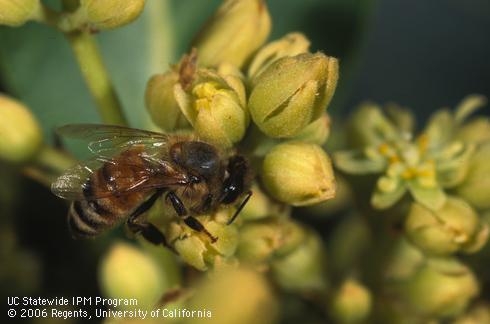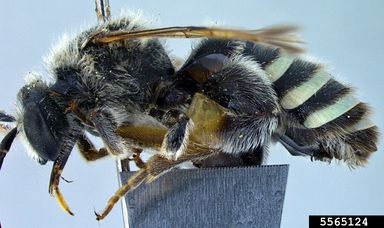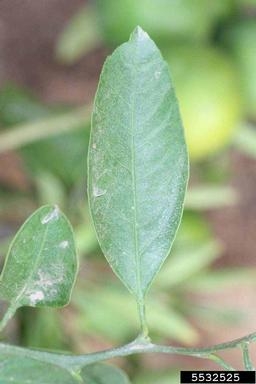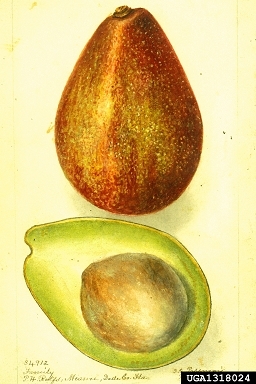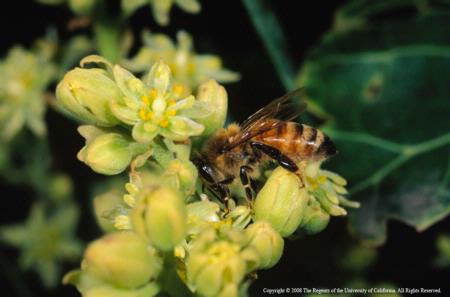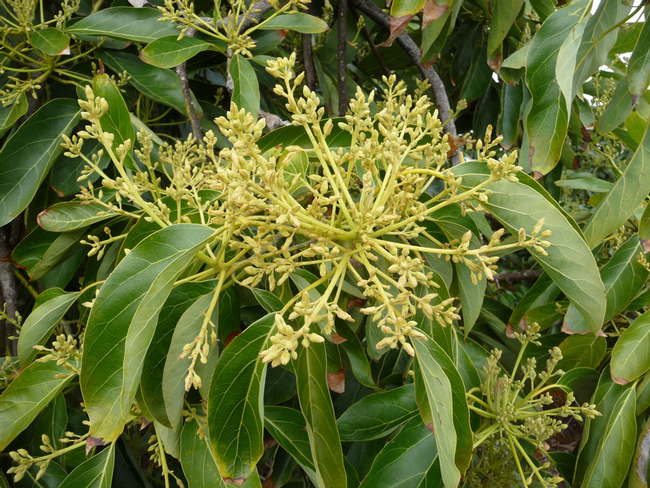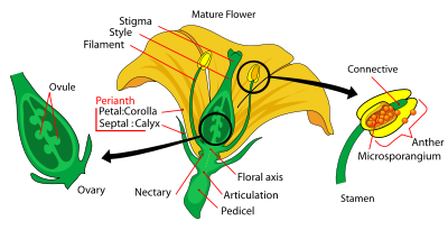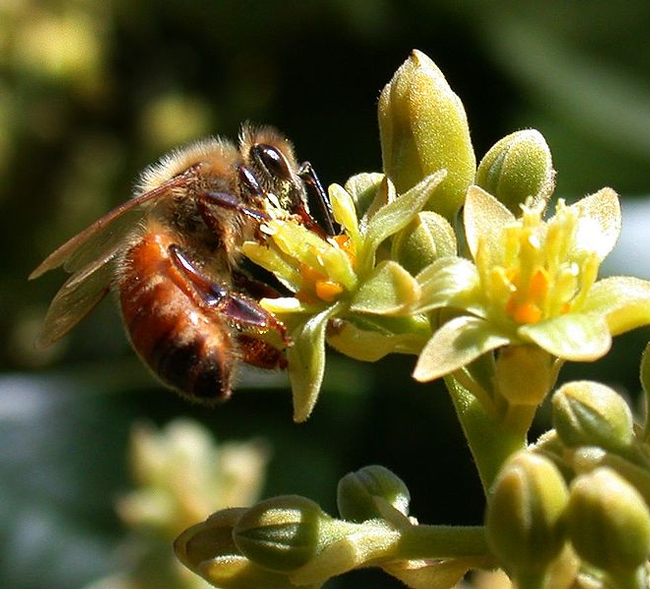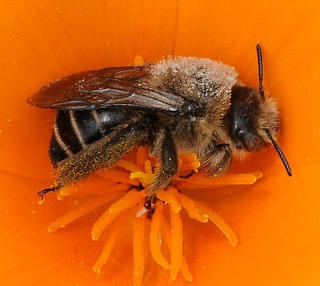- Author: Ben Faber
I recently came across a library of all kinds of images of pests, diseases and crops. It has lots of entries, such as “Bees of the United States”:
https://www.ipmimages.org/browse/projectsubject.cfm?proj=1154
Alkali bee
And images of citrus pests and diseases and even different cultivars of citrus, under “Citrus ID”:
https://www.ipmimages.org/browse/projectsubject.cfm?proj=108
'Xie Shan" citrus cultivar
And even a few avocado images:
https://www.ipmimages.org/browse/Areathumb.cfm?area=277
But there's a heck of a lot more.
Clicking on the different links and their volumes of images will take some time because of the shear number. The images have been collected as a public data base for not only academics, but also for the general public. At present, it's not too easy to search, but it's worth a look.
Here's a list of the different categories that can be perused:
Commodity Groups
Grain Sorghum and Small Grains
Grain Sorghum and Small Grains
Plant Pathogen and Microbe Culture Images
Forestry, Wildlife and Natural Resources
Taxonomy
Biological Controls
Damage Types
Insects
Bark Beetles and Phloem Feeders
Seed, Cone, Flower, Bud and Fruit Damaging Insects
Diseases
Parasitic and Epiphytic Plants




- Author: Sonia Rios
Avocado trees can appear completely covered with flowers. A typical full grown healthy avocado tree in California can produce up to a million flowers a year, but, on the average, fewer than 200 flowers per tree will set fruit that will hold and develop to maturity and harvest (about 10,000 lbs/acre, or less). Upon occasion, we have seen some groves with trees setting an average of 500 flowers per tree (25,000 lbs/acre), but this is rare. More commonly, only 100 flowers (or less) per tree will set and hold fruit to maturity (5,000 lbs/acre or less), much to the distress of growers (Bender 2013). Flowering is typically spread over six to eight weeks.
The avocado flower has both functional male and female organs. The male floral organ, which produces pollen, is comprised of the anthers and stamens. The female floral organ is comprised of the stigma (which receives the pollen), style and the ovary. The flowers are small (10 mm diameter). The flowers are usually only open for 2–6 hours, then close and open again for 2–6 hours on the second day. When a flower opens for a second time, it produces pollen and the stigma is not receptive. Flowers then close and remain closed. Flowers will usually be one sex in the morning, closed in the middle of the day and the opposite sex in the afternoon. The timing of the sex phases can be quite defined, but environmental conditions will affect the timing and duration of the male and female phases. The mature tree can produce in excess of a million flowers during the flowering period.
Avocado cultivars are classified in two groups (A or B) based upon their flowering behavior. In the type ‘A' cultivars, the female organs are receptive to pollen in the morning and the pollen is released in the afternoon. Unfortunately, most of the currently available "B" varieties are classed as "greenskins", which return less to growers. In the type B'cultivars, the pollen is released in the morning, while the female organs are receptive in the afternoon. Type A cultivars include: Hass, Gwen, Lamb Hass, Pinkerton, Reed, Gem, and Harvest. Type B cultivars include: Bacon, Ettinger, Fuerte, Sharwill, Sir Prize, Walter Hole, Zutano, Marvel and Nobel. Both type. It is believed that the interplanting of complementary flower types can boost fruit set and therefore yield by making pollen available. The separation in time of the male and female phases has led most observers to believe that a vector or "pollinator" is needed to move pollen from one flower to another.
Steps to take to Improve Pollination (Bender 2014):
1. Bring beehives into the grove. The University of California farm advisors have usually recommended 1 – 2 strong hives per acre, but Ish-Am (2000) suggests that 1 hive is rarely sufficient, and in many cases 4 hives are required. California growers usually have to rent hives (in 2002 hive rentals averaged $42 per hive), but sometimes beekeepers will drop a load of 80 hives for free if the grower has good bee forage nearby. Bees should have water available; floating boards on ponds or reservoirs enables them to land and drink without drowning.
2. Add pollinizers to the grove. Ish-Am recommends a pollinizer tree row be located at least every fourth row. Some growers in California use pollinizers as wind-breaks around the grove, and some replace thinned-out trees with pollinizers.
3. Keep the orchard open. Direct sunlight should reach the lower branches of each tree in order for the trees to produce a “wall” of flowers down the ground. In avocado production, this can only be accomplished by pruning the upper branches on a yearly basis. Keeping open channels through the grove encourages the flight of bees.
4. Other types of bees? Bumblebees have been reported to increase yield in avocados in Israel where honeybee populations were low. New World Carniolan bees have been used in an experiment in San Diego County for pollination: results were inconclusive as to whether they increased yield compared to Italian honeybees, but it was found that they gather more nectar from avocado (Fetscher et al. 2000). Work with these bees, and other wild bees, may eventually reveal a more efficient pollinator for avocado.
- Author: Ben Faber
Imagine going to the supermarket to stock up on groceries but coming home empty-handed because you just couldn't figure out how to work the shopping cart or figure out how to get to the ice cream tubs in the freezer aisle.
Welcome to the life of a bumblebee.
Gathering sweet nectar from flowers, it turns out, is much more difficult than one might think, and it requires a lengthy learning process. By the time a bee has figured out how to efficiently pry open the lips of a snapdragon flower, for example, most likely it has made dozens, if not hundreds, of floral visits.
How does a bee in charge of shopping for food needed to raise dozens of hungry larvae back in the hive learn to navigate the multitude of floral architectures it may encounter during an average workday, let alone over the course of its life?
Mostly by what biologists call associative learning, more widely known as trial and error, researchers have found. But while extensive research -- starting with famous bee researcher and Nobel laureate Karl von Frisch a century ago -- has focused on uncovering how bees forage for nectar, much less is known about how bees go about collecting pollen, which constitutes the most important protein source for the developing brood in the hive.
Avery Russell, Stephen Buchman and Daniel Papaj in the Department of Ecology and Evolutionary Biology at the University of Arizona decided to take a closer look. In a new paper published in the journal Behavioral Ecology, they tell a fascinating story of what is involved in a seemingly simple process of a bumblebee visiting a flower to gather pollen. And for the first time, they have untangled the subtle cues that a bee looks for when she visits a flower in search for pollen.
"For a long time, we have known that bees can learn all kinds of cues -- tactile, visual and olfactory -- when going after nectar rewards," says Russell, the study's first author. "When you open a can, you have to use a can opener, then use your fingers to pry the lid open. A bee might have to pop open the flower's petals, and might have to try many times over multiple trips until they get good at it. But not much was known in the context of pollen rewards."
Specifically, Russell and his co-authors wanted to know if bees need to learn in order to collect pollen efficiently from flowers that vary in their form. The research suggests they don't, and they don't need to.
"Our findings suggest that unlike nectar foraging, which requires complex learning behavior, bumblebees already know how to collect pollen," says Russell, who did the research as a doctoral student in the UA's Graduate Interdisciplinary Program in Entomology and Insect Science, "and they do it by switching between two responses that are seemingly hardwired into their brains."
Once a bumblebee touches down on a flower, it wastes no time. If it senses that the anthers are laden with abundant pollen just waiting to be shaken off like ripened apples from a tree, the bee does the obvious: a behavior that bee researchers call "scrabbling." Using its mandibles and legs, the bee brushes the pollen grains onto its body, then combs them off into collection baskets located on each of its hind legs.
"If you picture a happy toddler in a play pit filled with plastic balls, you get the idea of scrabbling," Russell says.
However, some flowers make their pollen grains more difficult to access, or sport intricate anther designs that dispense only a little bit of pollen at a time.
"That way, the plant makes sure pollinators don't eat it all, but carry it to other flowers for pollination instead, and also leave some for other visitors as well, so the flowers aren't limited to a single pollinator," he says.
When visiting some of these trickier flowers, Russell's team found, bumblebees switch to a different behavior called sonication -- or, in more familiar terms, buzzing. Not unlike a sonicating toothbrush that vibrates to shake plaque from teeth, a sonicating bee vibrates vigorously to free pollen grains hidden inside the flower.
The team observed that the bees switched between these two motor regimes depending on chemical and mechanical cues: They scrabbled when pollen was abundant, and sonicated when pollen was scarce, either because the flower already had been depleted or because its pollen is less accessible by design.
To tease apart the cues that trigger each behavior, the researchers made artificial flowers and treated some of them with chemical extracts from natural anthers. Bees visiting a surrogate flower without extract didn't stick around and took off again in search of more rewarding offerings. When they encountered a foam flower without pollen but with the chemical cue, they buzzed them in a futile attempt to harvest the nonexistent pollen. And when they sensed pollen grains, even artificial ones, scrabbling ensued.
"Bumblebees tend to sonicate on pollen-concealing anthers right away, but they also buzz accessible anthers when they can't detect pollen by touch," Russell says. "We think they do that in an effort to collect the dregs from a flower after most of its pollen has been harvested."
Being able to switch between two programmed routines allows bees to effectively collect pollen from flowers in many different shapes and forms, the researchers conclude. This flexibility also may explain a fact that had evolutionary biologists stumped for a long time: Flowers with concealed pollen stores evolved many times independently, suggesting that pollinators must always have had a way to harvest pollen from them, or else the co-evolution between the two would have led to a dead end and not survived.
"Researchers used to think that floral sonication is a behavior only used to collect pollen from concealed pollen stores," Russell says, "but because we often observe bees buzzing on flowers with accessible pollen, we conclude that it's a behavior that has evolved as a general strategy to collect pollen from any type of flower."
To buzz or to scrabble? To foraging bees, that's the question
Presenting bumblebees with various combinations of natural and artificial flowers laced with chemical and mechanical cues, UA biologists have discovered that for a bumblebee, foraging for pollen versus nectar is very different.
photo: honeybee on avocado flower. Is it buzzing or scrabbling?
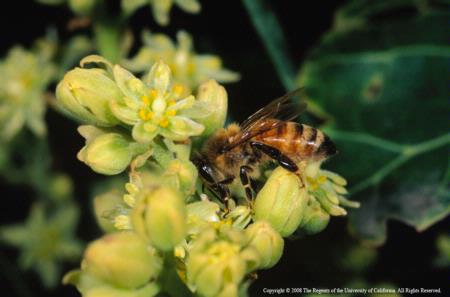
- Author: Ben Faber
Diadasia bituberculata – Digger Bee
The hills are alive with the sound of BEE-EEZZE. And often they are found crawling on the ground, as is the case of Digger Bees. At this time of year, they might be seen along the margins of avocado orchards, near hiking trails or in undisturbed areas of citrus orchards. They are called Digger Bees commonly, but this is just a generic name for a large group of bees that nest in the ground. There are many genera and species and because of the general lack of study of these bees they are lumped under the name Digger for lack of any greater knowledge and naming of them. In the case of this bee find reported here, they are possibly Diadasia bituberculata – as suggested by Robin Thorpe, retired UCD entomologist. They are uncommon in the rest of the world, but found here in California and western US.
There are several kinds of small hairy or metallic bees that dig into the soil to nest, hence the common name, digger bees. They are a diverse group that comes from different families and the term digger bee can include the andrenid bees, halictid bees, and colletid bees such as the plasterer and yellow-faced bees. These are solitary bees and native pollinators that are active early in the season. Each female digs a cylindrical underground tunnel as a nest where she reproduces (as opposed to social bees such as honey bees where only the queen reproduces and maintains a colony with the help of sterile workers). Although solitary, they form colonies that may have several hundred nests in one spot, but all nests are independently owned.
The subterranean nest is provisioned with a mixture of nectar and pollen collected from nearby flowering plants. This "bee-bread" is food for the bee's offspring (larvae) that develop in the underground chamber and emerge as adults the following year.
Digger bees are 1/4 to 1/2-inch-long and variable in color (mostly shiny metallic or dark, but some with markings of white, yellow or reddish brown). There is one generation of digger bees per summer and once the adults finish perpetuating the species by laying eggs of the next generation there will be no activity till the following spring.
Digger bee nests are commonly located in areas where grass and mulch are scarse, either from too much shade, previous drought conditions or other stress. Most of them like to fly around their airspace at different times of the day, something to do with mating, air temperature or staking territory. They often travel great distances to forage.
The threat of being stung by digger bees is unlikely. The bees are docile and not likely to sting unless handled or threatened. There is no nest guarding behavior or attack behavior like there is with social insects such as honey bees and yellowjacket wasps.
Image: Digger Bee "Colony", Thanks to Pest Control Adviser Jane Delahoyde's friend.
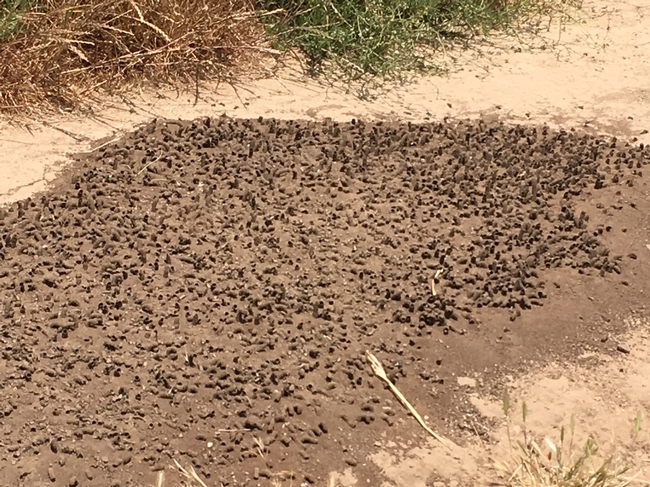
- Author: Christina Herrick
This article is from Florida Grower News. Thanks for Jim Lloyd-butler for pointing it out.
FLG-Editorial@MeisterMediaww.com
A sister species of the Varroa destructor mite is developing the ability to parasitize European honeybees, threatening pollinators already hard pressed by pesticides, nutritional deficiencies, and disease, a Purdue University study says.
Researchers found that some populations of Varroa jacobsoni mites are shifting from feeding and reproducing on Asian honeybees, their preferred host, to European honeybees, the primary species used for crop pollination and honey production worldwide. To bee researchers, it's a grimly familiar story: V. destructor made the same host leap at least 60 years ago, spreading rapidly to become the most important global health threat to European honeybees.
While host-switching V. jacobsoni mites have not been found outside of Papua New Guinea, Purdue researchers Gladys Andino and Greg Hunt say vigilance is needed to protect European honeybees worldwide from further risk.
“This could represent a real threat,” said Andino, a bioinformatics specialist with Information Technology at Purdue. “If this mite gets out of control and spreads, we might have another situation like V. destructor.”
Varroa mites are obligate parasites, meaning their lifecycle is inextricably entwined with that of their bee hosts. The mites can do serious damage to their hosts' health due to their relatively large size – “think of a tick as big as your fist,” Hunt said. Mites latch on to bees and feed on their hemolymph, insects' rough equivalent to blood, leaving behind open wounds that are susceptible to infection. They can also transmit diseases such as deformed wing virus and have been linked to colony collapse disorder.
To gain insight into the biology behind V. jacobsoni‘s host switch, Andino and Hunt, professor of behavioral genetics and honeybee specialist, studied the differences in gene expression between V. jacobsoni mites that fed and reproduced on Asian honeybees and those that parasitized European honeybees. Knowing which host cues mites respond to and the genes involved could lead to potential control strategies, the researchers said.
“If we can understand the mechanism, we might be able to disrupt, block, or manipulate that,” Andino said. “But first we have to understand what is happening and which genes are involved in allowing the mites to shift to a new host.”
Andino and Hunt said the mites' leap to European honeybees likely occurred within the last decade. Previously, V. jacobsoni mites were occasionally found on European honeybees but seemed unable to produce healthy offspring, limiting their destructive capacity.
Catching the host transition in its early stages will allow researchers to continue to investigate the complex genetic details behind the shift and monitor infected European honeybees, Hunt said.
“This happened once with one species of mite, and it looks like it's happening again. Maybe if we catch this as it's beginning, we'll be able to figure out why it's happening or, down the road, stop it.”
The paper was recently published in BMC Genomics.
Funding for the study and an ongoing genome-sequencing project was provided USDA's-Agricultural Research Service and the USDA National Institute of Food and Agriculture.
This article is from Florida Grower News
